This article was co-authored by Dee Dine and by wikiHow staff writer, Jessica Gibson. Dee Dine is a Nutrition and Vegan Food Specialist and the founder of Green Smoothie Gourmet, a blog dedicated to healthy, plant-based vegan, limited ingredient recipes. Dee holds a BS in Biology/Biochemistry with an emphasis in Immunology. Dee has written two books full of healthy plant-based recipes, including chocolate desserts, snacks, juices and, wellness shots. They are: "Crazy Healthy with 4 Ingredients: Dessert, Breakfast & Snack Vegan Recipes" and "4-Ingredient Smoothies and Juices: 100 Easy Nutritious Recipes for Lifelong Health". Dee is an editor with TheFeedFeed, a crowdsourced digital cooking publication, and has been featured on BuzzFeed, Marie Claire, the Academy of Culinary Nutrition, Well + Good, and Hello Glow.
There are 16 references cited in this article, which can be found at the bottom of the page.
This article has been viewed 67,726 times.
Maintaining your cholesterol might seem challenging, but if your levels are already normal, there are a few simple things you can do. First, learn your numbers so you know if your good cholesterol levels are up and your bad cholesterol levels are low. Then eat a healthy diet that includes lots of fiber, fresh produce, and lean proteins. Practice active lifestyle habits such as exercising, limiting alcohol, and quitting smoking to maintain healthy cholesterol levels.
Steps
Getting Your Cholesterol Checked
-
1Schedule an annual cholesterol screening. If you don't have a history of heart disease, you'll need to have blood work done annually to determine if your cholesterol is in a normal range. Keep in mind that regular screenings are important as you age since cholesterol levels usually increase due to lifestyle changes and decreased activity levels as you get older.[1]
- Your cholesterol level will appear as 3 numbers: your high-density lipoprotein (HDL), low-density lipoprotein (LDL), and triglycerides.
- If you do have a history of heart disease, your doctor will recommend that you get your cholesterol checked more frequently.
- To screen your cholesterol, you'll need to get a blood sample that's analyzed in a lab.
-
2Check your low-density lipoprotein (LDL) level. You've probably heard LDL referred to as "bad" or "lousy" cholesterol because high levels can slowly block the arteries. Check the LDL level from your cholesterol screening and see where it falls on this range:[2]
- Less than 100 md/dL: optimum
- 100 to 129 md/dL: fairly good
- 130 to 159 md/dL: borderline high
- 160 to 189 md/dL: high
- 190+ md/dL: very high
Advertisement -
3Learn your high-density lipoprotein (HDL) level. HDL is known as the good cholesterol because it helps maintain bone and joint function. It can also help reduce the buildup of LDL cholesterol in the arteries. Determine where your HDL level falls on this range:[3]
- 60+ mg/dL: optimum
- Less than 40 mg/dL in men: major risk
- Less than 50 mg/dL in women: major risk
-
4Check your triglycerides. Triglycerides are one of the most common types of fat in the body, comprised of both lipid fats and sugar, and they're found in your blood. If you have too many triglycerides in your blood, you're at an increased risk for heart disease, diabetes, and metabolic syndrome.[4]
- If your triglyceride level is 150 mg/dL or higher, talk with your doctor about lowering it.
-
5Talk with your doctor about taking cholesterol-lowering medication. If your doctor believes that your cholesterol levels are high and you have or are at risk for heart disease, the doctor may prescribe medication to quickly lower your cholesterol. Follow your doctor's treatment plan and get your levels checked again to determine that the medication is working.[5]
- If you're going through menopause and your cholesterol is high, ask the doctor if medication will help you maintain normal cholesterol levels.
Eating a Healthy Diet
-
1Consume 20 to 35 grams (1.2 oz) of fiber every day. Most people don't get the recommended amount of fiber in their diets. A diet rich in fiber, especially soluble fiber, is important for balancing HDL and LDL cholesterol. Eat whole grains and beans such as:[6]
- Oats
- Bran
- Barley
- Bean (navy, kidney, lentils, garbanzos)
- Whole grain pasta and bread
-
2Include a variety of fruits and vegetables in your diet. Eat 3 to 5 servings of fruits and vegetables every day. Fresh produce is high in fiber which will lower LDL and help you maintain your cholesterol.[7]
- Apples, grapes, strawberries, and citrus fruits are all good options to add to your diet.
- A serving is typically about half of a cup of fruits or vegetables.[8]
-
3Eat lean proteins and seafood throughout the week. To get the healthy protein that won't raise your cholesterol, eat soybeans and soy products, as well as lean meats and fresh seafood. Good sources of lean protein include:[9]
- Soy products such as tofu and soy milk
- Seafood such as salmon
- Skinless poultry
-
4Add foods rich in omega-3 fatty acids. Omega-3 fatty acids can improve the balance of LDL and HDL cholesterol levels and reduce triglycerides, so try to eat them every day. Some foods that are high in omega-3s include:[10]
- Fish
- Flax and flaxseed oil
- Chia seeds
- Walnuts
-
5Avoid foods high in saturated or trans fats. These fats will increase your LDL levels which could raise your overall cholesterol. Foods that include trans fats will raise your triglycerides and reduce your HDL. To maintain balanced cholesterol levels, avoid eating:[11]
- Red meat or fatty cuts of meat
- Fried foods
- Margarine and shortening[12]
- Baked goods such as cakes, cookies, and pastries
- Whole-fat dairy and eggs
- Oils such as palm oil and cocoa butter
-
6Cut back on how much sugar you're eating. If you eat more sugar than your body needs, it will turn to glucose in your blood. Your shunt that glucose into the liver, where it will turn into triglycerides and cholesterol. Nutrition and vegan food specialist Dee Dine instead suggests "replacing cane sugar and high-fructose corn syrup with maple syrup or honey as a healthier alternative."[13]
-
7Ask your doctor about taking a supplement to maintain your cholesterol. Research shows that fenugreek seed supplements are effective at maintaining normal blood cholesterol and that aged garlic extracts lower cholesterol levels. If you do decide to add a supplement, follow your doctor's dosage recommendations.[14]
- If you're concerned you're not getting enough soluble fiber, ask your doctor about adding a fiber supplement.
Improving Your Lifestyle
-
1Maintain a healthy weight. Use your height and weight to determine your body mass index (BMI). Then use the number to determine if you're at a healthy weight for your height. Since people who are overweight or obese tend to have higher cholesterol levels, try to keep your weight in a healthy range. BMI ranges include:[15]
- 18.5 to 24.9: normal
- 25 to 29.9: overweight
- 30+: obese
-
2Try to get 30 minutes of exercise every day. If you're trying to lose weight or maintain normal cholesterol levels, you'll need to exercise regularly. Studies have shown that moderate exercise increases your HDL, reduces LDL, and can lower triglycerides. For moderate exercises, try:[16]
- Walking
- Swimming
- Running
- Weight lifting
- Bike riding
-
3Practice stress relieving techniques. Research has shown that stress can directly raise cholesterol levels, so it's important to manage the stress in your life. To handle stress, use whatever technique works best for you. For example, take yoga classes, paint or draw, or practice deep breathing.[17]
- It's a good idea to use a variety of stress relieving techniques so you can use them in different settings. For example, if you can start meditating during a stressful meeting, you could take a few deep breaths.
-
4Quit smoking. Smoking cigarettes has been shown to lower good cholesterol levels (HDL), which causes bad cholesterol (LDL) to rise. Talk with your doctor about smoking cessation programs or find a support group in your area to help you quit.[18]
- Once you quit smoking, your blood pressure will recover within 20 minutes. Your blood circulation will also improve within 3 months of quitting.
-
5Limit alcoholic drinks to 1 or 2 a day. If you frequently drink more than 1 to 2 drinks a day, you'll increase your triglycerides. Moderate drinking can also raise your blood pressure and increase your risk for heart problems.[19]
- Women of all ages and men over 65 should limit drinking to 1 drink a day. Men under 65 should limit drinking to 2 drinks a day.
Foods to Eat to Maintain Normal Cholesterol
Expert Q&A
-
QuestionHow can I lower my sugar intake through diet?
 Anne Dunev, PhD, NP, ACNAnne Dunev is a certified Clinical Nutritionist, Naturopathic Practitioner, and Owner of Well Body Clinic, a wellness clinic in Los Angeles, California. With over 25 years of experience, Anne specializes in herbal medicine, functional medicine, women's health, hormonal balance, and digestion. Anne holds a BS in Health Sciences from Ohio State University and a PhD in Natural Medicine. Furthermore, Anne holds a post-doctorate certification in Applied Clinical Nutrition for the Southern California University of Health Sciences. She has taught clinical nutrition, kinesiology, and soft tissue manipulation at the College of Naturopathic Medicine in London, UK. She has been a featured speaker at the International Wellness Festivals in Sun Valley, Idaho and St. Hill, UK. Anne has also been a guest on over 150 radio and television programs. She is the author of the weight-loss book called, “The Fat Fix Diet”.
Anne Dunev, PhD, NP, ACNAnne Dunev is a certified Clinical Nutritionist, Naturopathic Practitioner, and Owner of Well Body Clinic, a wellness clinic in Los Angeles, California. With over 25 years of experience, Anne specializes in herbal medicine, functional medicine, women's health, hormonal balance, and digestion. Anne holds a BS in Health Sciences from Ohio State University and a PhD in Natural Medicine. Furthermore, Anne holds a post-doctorate certification in Applied Clinical Nutrition for the Southern California University of Health Sciences. She has taught clinical nutrition, kinesiology, and soft tissue manipulation at the College of Naturopathic Medicine in London, UK. She has been a featured speaker at the International Wellness Festivals in Sun Valley, Idaho and St. Hill, UK. Anne has also been a guest on over 150 radio and television programs. She is the author of the weight-loss book called, “The Fat Fix Diet”.
Certified Nutritionist & Naturopathic Practitioner Watch what you eat and drink. For instance, even if they don't contain sugar, processed foods made with white flour can break down into glucose when you eat them. Alcohol contains hidden sugars, as well.
Watch what you eat and drink. For instance, even if they don't contain sugar, processed foods made with white flour can break down into glucose when you eat them. Alcohol contains hidden sugars, as well. -
QuestionHow do you maintain a healthy lipid profile?
 Anne Dunev, PhD, NP, ACNAnne Dunev is a certified Clinical Nutritionist, Naturopathic Practitioner, and Owner of Well Body Clinic, a wellness clinic in Los Angeles, California. With over 25 years of experience, Anne specializes in herbal medicine, functional medicine, women's health, hormonal balance, and digestion. Anne holds a BS in Health Sciences from Ohio State University and a PhD in Natural Medicine. Furthermore, Anne holds a post-doctorate certification in Applied Clinical Nutrition for the Southern California University of Health Sciences. She has taught clinical nutrition, kinesiology, and soft tissue manipulation at the College of Naturopathic Medicine in London, UK. She has been a featured speaker at the International Wellness Festivals in Sun Valley, Idaho and St. Hill, UK. Anne has also been a guest on over 150 radio and television programs. She is the author of the weight-loss book called, “The Fat Fix Diet”.
Anne Dunev, PhD, NP, ACNAnne Dunev is a certified Clinical Nutritionist, Naturopathic Practitioner, and Owner of Well Body Clinic, a wellness clinic in Los Angeles, California. With over 25 years of experience, Anne specializes in herbal medicine, functional medicine, women's health, hormonal balance, and digestion. Anne holds a BS in Health Sciences from Ohio State University and a PhD in Natural Medicine. Furthermore, Anne holds a post-doctorate certification in Applied Clinical Nutrition for the Southern California University of Health Sciences. She has taught clinical nutrition, kinesiology, and soft tissue manipulation at the College of Naturopathic Medicine in London, UK. She has been a featured speaker at the International Wellness Festivals in Sun Valley, Idaho and St. Hill, UK. Anne has also been a guest on over 150 radio and television programs. She is the author of the weight-loss book called, “The Fat Fix Diet”.
Certified Nutritionist & Naturopathic Practitioner One of the best ways to lower your cholesterol is to watch what kind of sugar and how much sugar you're eating. If you cut refined sugar out of your diet, your cholesterol numbers can sometimes drop very dramatically. That's because if you eat more sugar than your body can use, it turns into glucose, which your liver then turns into triglycerides and cholesterol.
One of the best ways to lower your cholesterol is to watch what kind of sugar and how much sugar you're eating. If you cut refined sugar out of your diet, your cholesterol numbers can sometimes drop very dramatically. That's because if you eat more sugar than your body can use, it turns into glucose, which your liver then turns into triglycerides and cholesterol. -
QuestionWhat are some sweet treats I can eat while watching my cholesterol?
 Dee DineDee Dine is a Nutrition and Vegan Food Specialist and the founder of Green Smoothie Gourmet, a blog dedicated to healthy, plant-based vegan, limited ingredient recipes. Dee holds a BS in Biology/Biochemistry with an emphasis in Immunology. Dee has written two books full of healthy plant-based recipes, including chocolate desserts, snacks, juices and, wellness shots. They are: "Crazy Healthy with 4 Ingredients: Dessert, Breakfast & Snack Vegan Recipes" and "4-Ingredient Smoothies and Juices: 100 Easy Nutritious Recipes for Lifelong Health". Dee is an editor with TheFeedFeed, a crowdsourced digital cooking publication, and has been featured on BuzzFeed, Marie Claire, the Academy of Culinary Nutrition, Well + Good, and Hello Glow.
Dee DineDee Dine is a Nutrition and Vegan Food Specialist and the founder of Green Smoothie Gourmet, a blog dedicated to healthy, plant-based vegan, limited ingredient recipes. Dee holds a BS in Biology/Biochemistry with an emphasis in Immunology. Dee has written two books full of healthy plant-based recipes, including chocolate desserts, snacks, juices and, wellness shots. They are: "Crazy Healthy with 4 Ingredients: Dessert, Breakfast & Snack Vegan Recipes" and "4-Ingredient Smoothies and Juices: 100 Easy Nutritious Recipes for Lifelong Health". Dee is an editor with TheFeedFeed, a crowdsourced digital cooking publication, and has been featured on BuzzFeed, Marie Claire, the Academy of Culinary Nutrition, Well + Good, and Hello Glow.
Nutrition & Vegan Food Specialist A few snacks you could eat that would help lower your cholesterol would be orange or apple slices dipped in hummus, or a mixture of apples and oats stirred together with cinnamon and microwaved for 60 seconds. You could also have berries tossed with oats and chia seeds or melted dark chocolate with fruit and walnuts tossed in.
A few snacks you could eat that would help lower your cholesterol would be orange or apple slices dipped in hummus, or a mixture of apples and oats stirred together with cinnamon and microwaved for 60 seconds. You could also have berries tossed with oats and chia seeds or melted dark chocolate with fruit and walnuts tossed in.
References
- ↑ https://www.cdc.gov/cholesterol/checked.htm
- ↑ https://medlineplus.gov/ldlthebadcholesterol.html
- ↑ https://medlineplus.gov/cholesterollevelswhatyouneedtoknow.html
- ↑ https://www.urmc.rochester.edu/encyclopedia/content.aspx?contenttypeid=56&contentid=2967
- ↑ https://www.heart.org/en/health-topics/cholesterol/prevention-and-treatment-of-high-cholesterol-hyperlipidemia/cholesterol-medications
- ↑ https://www.eatright.org/food/vitamins-and-supplements/types-of-vitamins-and-nutrients/easy-ways-to-boost-fiber-in-your-daily-diet
- ↑ https://www.health.harvard.edu/heart-health/11-foods-that-lower-cholesterol
- ↑ Anne Dunev, PhD, NP, ACN. Certified Nutritionist & Naturopathic Practitioner. Expert Interview. 2 September 2020.
- ↑ https://www.health.harvard.edu/heart-health/11-foods-that-lower-cholesterol
- ↑ https://health.clevelandclinic.org/from-fiber-to-fish-oil-natural-ways-to-lower-your-cholesterol/
- ↑ https://www.heart.org/en/healthy-living/healthy-eating/eat-smart/fats/trans-fat
- ↑ Anne Dunev, PhD, NP, ACN. Certified Nutritionist & Naturopathic Practitioner. Expert Interview. 2 September 2020.
- ↑ https://health.clevelandclinic.org/sweet-tooth-spells-trouble-heart/
- ↑ https://health.clevelandclinic.org/from-fiber-to-fish-oil-natural-ways-to-lower-your-cholesterol/
- ↑ https://www.nhlbi.nih.gov/health/educational/lose_wt/BMI/bmicalc.htm
- ↑ https://health.clevelandclinic.org/does-exercise-lower-cholesterol/
- ↑ https://www.helpguide.org/articles/stress/quick-stress-relief.htm
- ↑ https://www.helpguide.org/articles/addictions/how-to-quit-smoking.htm
- ↑ https://health.clevelandclinic.org/does-alcohol-affect-cholesterol/
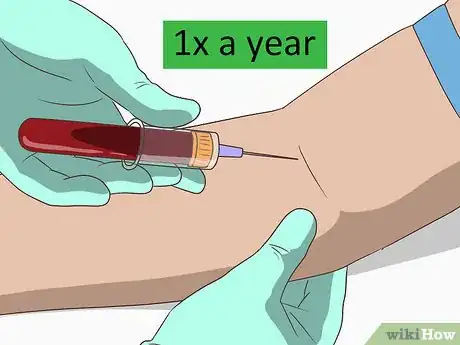
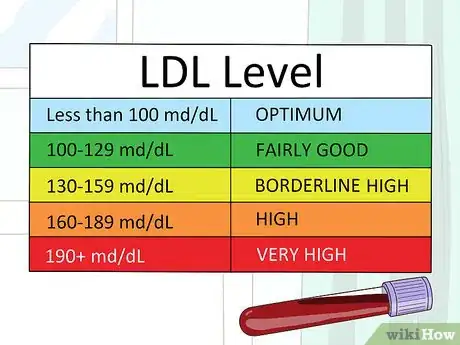
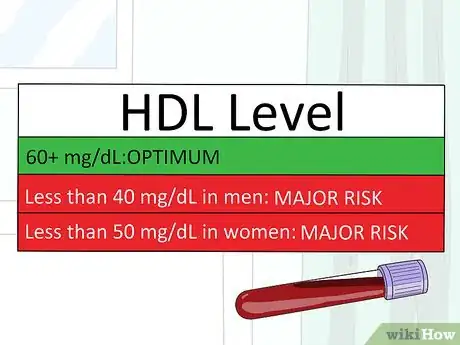


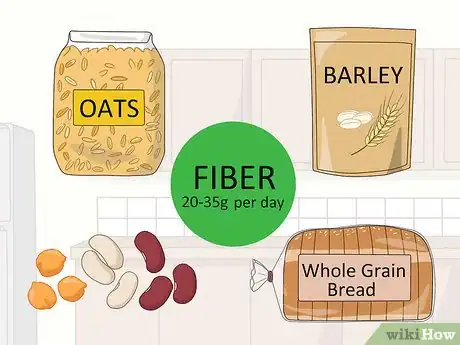


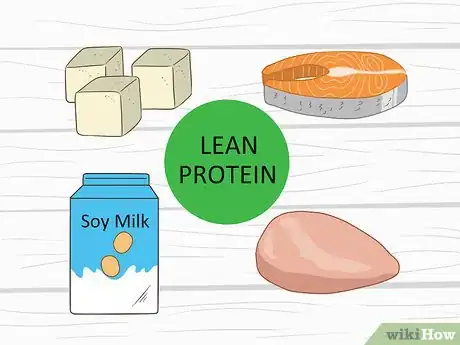


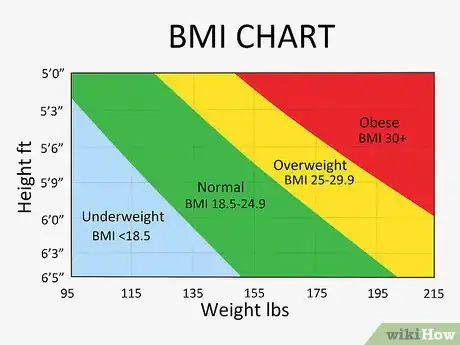

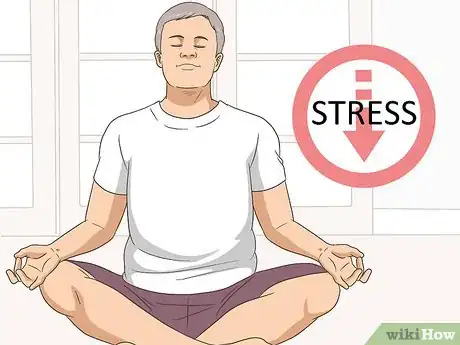
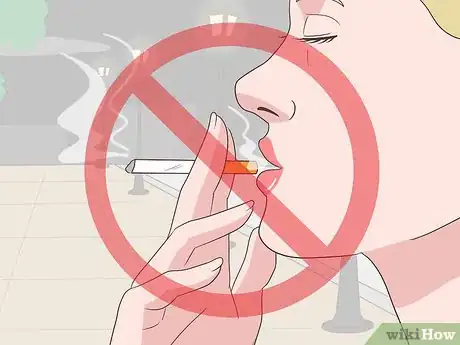
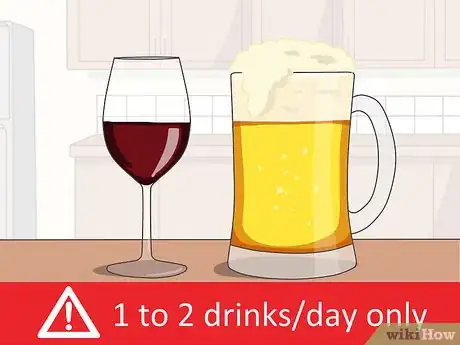
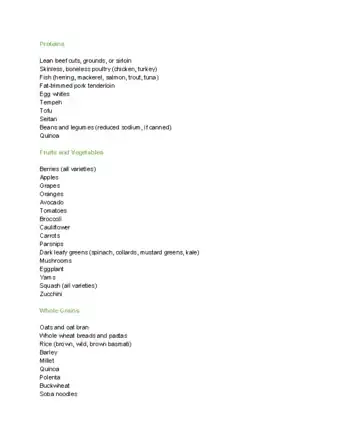
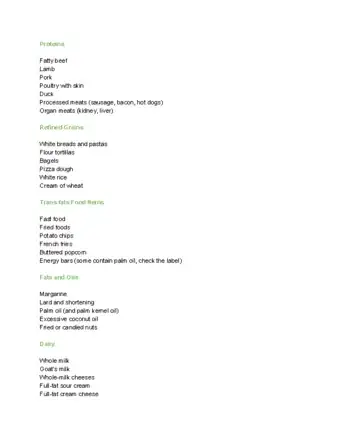

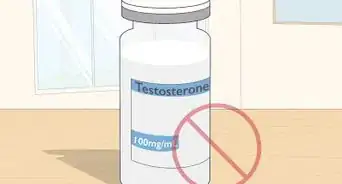

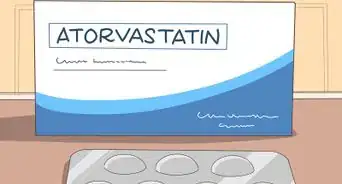




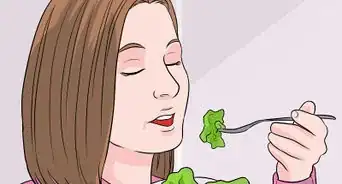





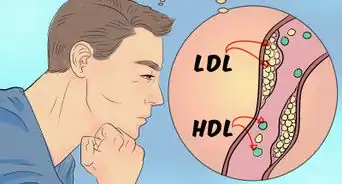







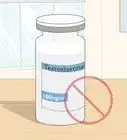

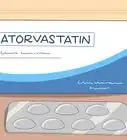
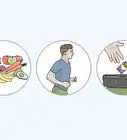



































Medical Disclaimer
The content of this article is not intended to be a substitute for professional medical advice, examination, diagnosis, or treatment. You should always contact your doctor or other qualified healthcare professional before starting, changing, or stopping any kind of health treatment.
Read More...